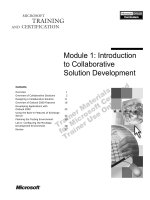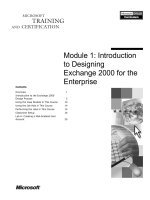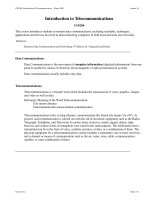Tài liệu Module 1: Introduction to Developing a Migration Strategy doc
Bạn đang xem bản rút gọn của tài liệu. Xem và tải ngay bản đầy đủ của tài liệu tại đây (790.22 KB, 10 trang )
#
&RQWHQWV##
#
2YHUYLHZ#4
#
,QWURGXFWLRQ#WR#'HYHORSLQJ#D##
0LJUDWLRQ#6WUDWHJ\#5
#
8SJUDGLQJ#9HUVXV#5HVWUXFWXULQJ#7
#
7KH#,PSRUWDQFH#RI#3ODQQLQJ#8
#
5HYLHZ#9
#
#
Module 1: Introduction
to Developing a
Migration Strategy
#
Information in this document is subject to change without notice. The names of companies,
products, people, characters, and/or data mentioned herein are fictitious and are in no way intended
to represent any real individual, company, product, or event, unless otherwise noted. Complying
with all applicable copyright laws is the responsibility of the user. No part of this document may
be reproduced or transmitted in any form or by any means, electronic or mechanical, for any
purpose, without the express written permission of Microsoft Corporation. If, however, your only
means of access is electronic, permission to print one copy is hereby granted.
Microsoft may have patents, patent applications, trademarks, copyrights, or other intellectual
property rights covering subject matter in this document. Except as expressly provided in any
written license agreement from Microsoft, the furnishing of this document does not give you any
license to these patents, trademarks, copyrights, or other intellectual property.
2000 Microsoft Corporation. All rights reserved.
Microsoft, MS, Windows, Windows NT, Active Directory, and Windows 2000 are either
registered trademarks or trademarks of Microsoft Corporation in the U.S.A. and/or other countries.
The names of companies, products, people, characters, and/or data mentioned herein are fictitious
and are in no way intended to represent any real individual, company, product, or event, unless
otherwise noted.
Other product and company names mentioned herein may be the trademarks of their respective
owners.
Project Lead/Instructional Designer:
Sangeeta Garg (NIIT (USA) Inc.)
Lead Program Manager:
Angie Fultz
Instructional Designer:
Robert Deupree (S&T OnSite)
Subject Matter Expert
: Brian Komar (3947018 Manitoba Inc)
Technical Contributors:
John Pritchard, Greg Parsons, David Cross, Rodney Fournier, Tony de
Freitas, Christoph Felix, Shaun Hayes, Megan Camp, Richard Maring, Glenn Pittaway, Anne
Hopkins, Bob Heath, Jeff Newfeld, Jim Glynn, Paul Thompson (Mission Critical Software, Inc.),
David Stern, Lyle Curry, Steve Tate, Bill Wade (Wadeware LLC).
Testing Leads:
Sid Benavente, Keith Cotton
Testing Developer:
Greg Stemp (S&T Onsite)
Testers:
Testing Testing 123
Instructional Design Consultants:
Susan Greenberg, Paul Howard
Instructional Design Contributor:
Kathleen Norton
Graphic Artist:
Kirsten Larson (S&T OnSite)
Editing Manager:
Lynette Skinner
Editors:
Marilyn McCune (Sole Proprietor), Wendy Cleary (S&T OnSite), Jane Ellen Combelic
(S&T OnSite)
Copy Editor:
Shawn Jackson
(
S&T Consulting)
Online Program Manager:
Debbi Conger
Online Publications Manager:
Arlo Emerson (Aditi)
Online Support:
Eric Brandt (S&T Onsite)
Multimedia Development:
Kelly Renner (Entex)
Testing Leads:
Sid Benavente, Keith Cotton
Testing Developer:
Greg Stemp (S&T OnSite)
Courseware Testing:
Data Dimensions, Inc.
Production Support:
Lori Walker (S&T Consulting)
Manufacturing Manager:
Rick Terek (S&T Onsite)
Manufacturing Support:
Laura King (S&T Onsite)
Lead Product Manager, Development Services:
Bo Galford
Lead Product Managers:
Dean Murray, Ken Rosen
Group Product Manager:
Robert Stewart
# 0RGXOH#4=#,QWURGXFWLRQ#WR#'HYHORSLQJ#D#0LJUDWLRQ#6WUDWHJ\##LLL#
,QVWUXFWRU#1RWHV#
This module provides students with the foundation for designing a migration
strategy from Microsoft
®
Windows NT
®
version 4.0 to Microsoft Windows
®
2000 Active Directory
™
directory service. The module introduces the migration
concepts and explains the steps that an enterprise must consider and include in
the overall migration strategy.
There is no lab for this module.
At the end of this module, students will be able to:
„# Explain the phases in the migration planning process.
„# Differentiate between domain upgrade and domain restructure.
„# Explain the importance of planning.
0DWHULDOV#DQG#3UHSDUDWLRQ#
This section provides you with the required materials and preparation tasks that
are needed to teach this module.
5HTXLUHG#0DWHULDOV#
To teach this module, you need the following materials:
„# Microsoft PowerPoint
®
file 2010A_01.ppt
„# Module 1, “Introduction to Developing a Migration Strategy”
3UHSDUDWLRQ#7DVNV#
To prepare for this module, you should:
„# Read all of the materials for this module.
„# Read all of the delivery tips.
„# Read the white paper, “Planning Migration from Microsoft Windows NT to
Microsoft Windows 2000,” on the Student Materials compact disc.
3UHVHQWDWLRQ=#
48#0LQXWHV#
#
/DE=#
3#0LQXWHV#
LY##0RGXOH#4=#,QWURGXFWLRQ#WR#'HYHORSLQJ#D#0LJUDWLRQ#6WUDWHJ\#
0RGXOH#6WUDWHJ\#
Use the following strategy to present this module:
„# Introduction to Developing a Migration Strategy
Describe the four phases of domain migration planning.
Emphasize that this course assumes that the first phase, designing an Active
Directory forest, has been completed.
„# Upgrading Versus Restructuring
Define domain upgrade and domain restructure.
Describe the benefits of domain upgrade and domain restructure.
„# The Importance of Planning
Explain the need for planning and why planning migration is critical to its
success.
# 0RGXOH#4=#,QWURGXFWLRQ#WR#'HYHORSLQJ#D#0LJUDWLRQ#6WUDWHJ\##4#
2YHUYLHZ#
„
,QWURGXFWLRQ#WR#'HYHORSLQJ#D#0LJUDWLRQ#6WUDWHJ\
„
8SJUDGLQJ#9HUVXV#5HVWUXFWXULQJ
„
7KH#,PSRUWDQFH#RI#3ODQQLQJ
An organization may migrate to Microsoft
®
Windows
®
2000 to gain a
competitive advantage in the marketplace or to establish an enterprise
architecture that supports anticipated growth. This module provides a
foundation for designing a migration strategy from Microsoft Windows NT
®
version 4.0 to the Windows 2000 Active Directory
™
directory service. The
module explains the basic steps that an enterprise must consider and include in
the overall migration strategy.
At the end of this module, you will be able to:
„# Explain the phases in the migration planning process.
„# Differentiate between a domain upgrade and a domain restructure.
„# Explain the importance of planning.
6OLGH#2EMHFWLYH#
7R#SURYLGH#DQ#RYHUYLHZ#RI#
WKH#PRGXOH#WRSLFV#DQG#
REMHFWLYHV1#
/HDG0LQ#
,Q#WKLV#PRGXOH/#\RX#ZLOO#OHDUQ#
DERXW#WKH#SKDVHV#RI#GRPDLQ#
PLJUDWLRQ#SODQQLQJ#DQG#WKH#
GLIIHUHQFH#EHWZHHQ#D#
GRPDLQ#XSJUDGH#DQG#D#
GRPDLQ#UHVWUXFWXUH1#
5# # 0RGXOH#4=#,QWURGXFWLRQ#WR#'HYHORSLQJ#D#0LJUDWLRQ#6WUDWHJ\#
,QWURGXFWLRQ#WR#'HYHORSLQJ#D#0LJUDWLRQ#6WUDWHJ\#
Design the Active Directory Forest
Design the Active Directory Forest
Choose a Migration Path to Windows 2000 Active Directory
Choose a Migration Path to Windows 2000 Active Directory
Develop a Domain Upgrade or Restructure Strategy
Develop a Domain Upgrade or Restructure Strategy
Plan Deployment of Migration Strategy
Plan Deployment of Migration Strategy
1
1
1
2
2
2
3
3
3
4
4
4
Before proceeding with the actual migration, it is important to understand the
process of planning a strategy to migrate from a Windows NT 4.0 domain
structure to Active Directory. Migrating successfully from Windows NT 4.0 to
Windows 2000 requires in-depth planning based on careful analysis of your
current infrastructure. The overall migration strategy will include several phases
and mini-plans. The following are the phases that an enterprise must complete
to successfully develop a Windows 2000 Active Directory migration strategy:
1. Design the required Active Directory forest.
The Active Directory design identifies the migration project’s end goal, the
ideal domain infrastructure for an organization. This phase involves
designing an Active Directory structure that suits your business needs.
For information on designing Windows 2000 Active Directory, see
course 1561B, Designing a Microsoft Windows 2000 Directory Services
Infrastructure.
2. Choose a migration path.
This phase involves carefully comparing your business or migration goals
with the capabilities of each migration path to select a path that meets your
needs. The migration path that you choose will affect the remainder of your
migration planning.
3. Develop a domain upgrade or a restructure strategy.
After you have chosen a migration path, you can begin planning for the
actual upgrade or restructure process. Within the overall migration strategy,
you will define the steps that you will perform to achieve your desired
Active Directory structure.
6OLGH#2EMHFWLYH#
7R#SUHVHQW#WKH#SKDVHV#LQ#WKH#
SODQQLQJ#SURFHVV#IRU#
PLJUDWLQJ#GRPDLQV1#
/HDG0LQ#
0LJUDWLQJ#VXFFHVVIXOO\#IURP#
:LQGRZV#17#713#WR#
:LQGRZV#5333#UHTXLUHV#LQ0
GHSWK#SODQQLQJ#EDVHG#RQ#
FDUHIXO#DQDO\VLV#RI#\RXU#
FXUUHQW#LQIUDVWUXFWXUH1#
7KLV#FRXUVH#DVVXPHV#WKDW#
WKH#ILUVW#SKDVH/#GHVLJQLQJ#DQ#
$FWLYH#'LUHFWRU\#IRUHVW/#KDV#
DOUHDG\#EHHQ#FRPSOHWHG1#
7KLV#FRXUVH#FRYHUV#WKH#
UHPDLQLQJ#WKUHH#VWDJHV#RI#
GRPDLQ#PLJUDWLRQ#SODQQLQJ#
DQG#IURP#WKLV#SRLQW#IRUZDUG#
XVHV#WKH#WHUP#PLJUDWLRQ#
SODQQLQJ#LQ#UHIHUHQFH#WR#WKH#
ODVW#WKUHH#VWDJHV#SUHVHQWHG#
LQ#WKH#VOLGH1#
1RWH#
# 0RGXOH#4=#,QWURGXFWLRQ#WR#'HYHORSLQJ#D#0LJUDWLRQ#6WUDWHJ\##6#
4. Plan deployment of migration strategy.
The final phase of the planning process is the development of a deployment
plan. The deployment plan details the steps necessary to implement the
migration strategy.
7# # 0RGXOH#4=#,QWURGXFWLRQ#WR#'HYHORSLQJ#D#0LJUDWLRQ#6WUDWHJ\#
8SJUDGLQJ#9HUVXV#5HVWUXFWXULQJ#
Domain Mi
g
ration
Kerberos
Windows 2000
OU
OU
OU
OU
OU
OU
Kerberos
Windows 2000
Domain
Upgrade
Domain
Restructure
Windows NT 4
1
1
2
2
2
2
3
3
3
3
Up
g
rade
Up
g
rade
Up
g
rade
ƒ
Maintains current domain model
ƒ
Retains most of the system settings,
preferences, and application installations
ƒ
Maintains current domain model
ƒ
Retains most of the system settings,
preferences, and application installations
Restructure
Restructure
Restructure
ƒ
Results in fewer, larger domains
ƒ
May reduce administrative overhead
ƒ
Results in fewer, larger domains
ƒ
May reduce administrative overhead
If you assume that the pre-migration environment is the existing Windows NT
4.0 environment, the whole process of migration involves moving from that
environment to Windows 2000 Active Directory.
Performing a Windows 2000 domain migration is a very flexible process. Some
organizations may only upgrade, or upgrade first and then restructure second.
Still others may restructure from the start. The following are two approaches for
achieving migration from Windows NT 4.0 to the desired Active Directory
infrastructure:
„# Domain upgrade. Sometimes referred to as an in-place upgrade or just
upgrade, this is the process of upgrading the primary domain controller
(PDC) and the backup domain controllers (BDCs) of a Windows NT 4.0
domain from Windows NT 4.0 to Windows 2000. Domain upgrade is a
process designed to maintain as much of your current environment as
possible. Upgrade may represent the easiest, lowest-risk migration route
because it retains most of your system settings, preferences, and network
service configurations.
„# Domain restructure. Domain restructure is a process that enables you to
redesign the domain structure according to the needs of your organization.
Although a domain restructure can result in any number of different
outcomes, it typically reorganizes your current structure into fewer, larger
domains.
You accomplish restructuring in Windows 2000 by moving security
principles between domains. This allows an organization to first design an
ideal Active Directory forest, and then populate it with users, groups, and
computers. For example, you can convert a typical Windows NT multi-
master domain model into a less complicated, single Active Directory
domain in Windows 2000. Restructuring the domain results in reduced
administrative overhead by reducing the number of domains and trusts that
require administration and improving overall manageability.
6OLGH#2EMHFWLYH#
7R#LQWURGXFH#GRPDLQ#
XSJUDGH#DQG#GRPDLQ#
UHVWUXFWXUH1#
/HDG0LQ#
0LJUDWLRQ#WR#:LQGRZV#5333#
FDQ#EH#DFKLHYHG#E\#HLWKHU#
XSJUDGLQJ#RU#UHVWUXFWXULQJ1#
+RZHYHU/#WKH#WZR#DUH#QRW#
PXWXDOO\#H[FOXVLYH1#6RPH#
RUJDQL]DWLRQV#PD\#XSJUDGH#
ILUVW#DQG#UHVWUXFWXUH#VHFRQG/#
ZKLOH#RWKHUV#PD\#UHVWUXFWXUH#
DW#WKH#EHJLQQLQJ1#
(PSKDVL]H#WKDW#WKH#WHUP#
PLJUDWLRQ#LV#XVHG#WKURXJKRXW#
WKLV#FRXUVH#DV#D#JHQHUDO#
WHUP#WKDW#PD\#UHIHU#WR#DQ\#RI#
WKHVH#SURFHVVHV1#
'XULQJ#\RXU#GHOLYHU\/#EH#
FRQVFLHQWLRXV#DERXW#XVLQJ#
WKH#DSSURSULDWH#WHUPV/#
EHFDXVH#VWXGHQWV#PD\#
EHFRPH#FRQIXVHG#E\#WKH#
GLIIHUHQW#PLJUDWLRQ#SDWKV1#
(PSKDVL]H#WKDW#GRPDLQ#
PLJUDWLRQ#LV#D#YHU\#IOH[LEOH#
SURFHVV#ZLWK#PDQ\#SRVVLEOH#
SHUPXWDWLRQV1#
# 0RGXOH#4=#,QWURGXFWLRQ#WR#'HYHORSLQJ#D#0LJUDWLRQ#6WUDWHJ\##8#
7KH#,PSRUWDQFH#RI#3ODQQLQJ#
„
3ODQQLQJ
z
,V#DQ#RSSRUWXQLW\#WR#DOLJQ#,7#JRDOV#ZLWK#EXVLQHVV#JRDOV
z
+HOSV#GHWHFW#KRZ#D#FKDQJH#WR#RQH#DUHD#RI#WKH#HQWHUSULVH#ZLOO#
LPSDFW#RWKHUV
z
,GHQWLILHV#RSSRUWXQLWLHV#WR#DGG#YDOXH#WR#WKH#EXVLQHVV
z
$OORZV#WHFKQRORJ\#WR#EH#LPSOHPHQWHG#LQ#D#SURDFWLYH/#
FRRUGLQDWHG/#DQG#IRFXVHG##PDQQHU
z
0DNHV#HIILFLHQFLHV#SRVVLEOH
z
5HGXFHV#WKH#FRPSOH[LW\#RI#PLJUDWLRQ
Thoroughly planning your migration is critical to its success. In the planning
phase, a project team documents and analyzes the current network environment
of the organization. The team also measures the gap between the current
environment and the goals for the future, and it defines the steps to achieve
those results. Having a thorough plan allows the project team to concentrate on
the migration essentials and provide results that can be implemented effectively.
Planning:
„# Is an opportunity to align information technology (IT) goals with business
goals, enhance core business processes, or provide competitive advantages
in the marketplace.
„# Helps detect how a change to one area of the enterprise will impact others.
„# Identifies opportunities to add value to the business side of the organization
by applying technology in an innovative way.
„# Allows technology to be implemented in a proactive, coordinated, and
focused manner based on business strategy.
„# Makes efficiencies possible, such as eliminating duplication of effort and
reusing and leveraging IT investments and resources.
„# Reduces the complexity of migration and the risks that change introduces.
6OLGH#2EMHFWLYH#
7R#H[SODLQ#ZK\#SODQQLQJ#LV#
LPSRUWDQW1#
/HDG0LQ#
+DYLQJ#D#WKRURXJK#SODQ#
DOORZV#WKH#SURMHFW#WHDP#WR#
FRQFHQWUDWH#RQ#WKH#PLJUDWLRQ#
HVVHQWLDOV#DQG#SURYLGH#
UHVXOWV#WKDW#FDQ#EH#
LPSOHPHQWHG#HIIHFWLYHO\1#
<RX#VKRXOG#HPSKDVL]H#
WKURXJKRXW#WKH#FRXUVH#WKDW#
PRYLQJ#WR#:LQGRZV#5333#
UHTXLUHV#D#VKLIW#LQ#WKH#ZD\#
WKDW#SHRSOH#WKLQN#DERXW#
GRPDLQV#DQG#GRPDLQ#
DGPLQLVWUDWLRQ1#
9# # 0RGXOH#4=#,QWURGXFWLRQ#WR#'HYHORSLQJ#D#0LJUDWLRQ#6WUDWHJ\#
5HYLHZ#
„
,QWURGXFWLRQ#WR#'HYHORSLQJ#D#0LJUDWLRQ#6WUDWHJ\
„
8SJUDGLQJ#9HUVXV#5HVWUXFWXULQJ
„
7KH#,PSRUWDQFH#RI#3ODQQLQJ
1. What are the phases that an enterprise must complete to successfully
develop a Windows 2000 Active Directory migration strategy?
Designing the required Active Directory forest, choosing a migration
path, developing a domain upgrade or a restructure strategy, and
planning deployment of the migration strategy.
2. Explain the difference between a domain upgrade and a domain restructure.
A domain upgrade is the process of upgrading the Windows NT 4.0
PDC and the BDCs of a domain to Windows 2000 Server. A domain
restructure, alternatively, is a redesign of the existing domain structure,
which usually results in fewer, larger domains.
6OLGH#2EMHFWLYH#
7R#UHLQIRUFH#PRGXOH#
REMHFWLYHV#E\#UHYLHZLQJ#NH\#
SRLQWV1#
/HDG0LQ#
7KH#UHYLHZ#TXHVWLRQV#FRYHU#
VRPH#RI#WKH#NH\#FRQFHSWV#
WDXJKW#LQ#WKH#PRGXOH1#









